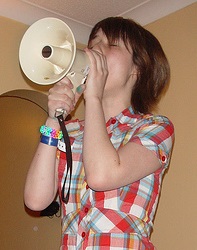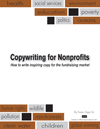Too many nonprofits are afraid to be different. They get so hung up about being “professional” that they forget about being human. And I find that quite ironic for a charity.
 In your copy – the words within your direct mail letters, emails, text messages, newsletters, press releases, case studies, social media updates, etc. – you must sound like a human. And you must also stand out from the crowd.
In your copy – the words within your direct mail letters, emails, text messages, newsletters, press releases, case studies, social media updates, etc. – you must sound like a human. And you must also stand out from the crowd.
Sometimes I feel like I harp on this topic to the point of nausea. If you’re already a master at writing this way – sorry to bug you once again. On the other hand, if you’re like the vast majority – please study this post carefully and be willing to change.
Jeff Bullas recently shared seven tips to finding “your” writing voice. And that’s what prompted me to write about this topic once again.
Here are his 7 tips with my twist added to make them more relevant for fundraising copywriting:
1 – Show your personality
When representing your charity (or association), you might not have as much leeway in letting your personality shine through as an individual does. Nonetheless, it’s important for the signer of your letters and emails to push the envelope a bit. If you’re dull and boring and sound like an institution spouting the same ole’ message . . . how can that possibly inspire anyone to donate?
2 – Display your humor
Why not? Have a bit of fun. Especially within social media. Although I admit you have to be careful with humor. Perhaps you can gently introduce it by relating what your nonprofit does to a popular movie comedy; using a movie to make a point in a fun way. Or have someone create a warm cartoon. Get creative.
3 – Put yourself in your audience’s shoes
This is HUGE for charities and associations! One way to do this is to use the Stanislavsky method. Think like a donor. And the longer you’ve been working at your charity, the harder this is to do.
4 – Expose your imperfections
Nobody’s perfect. This includes your nonprofit. When you make a mistake; fess up to it right away.
Another way of looking at this is that the stories related to your organization are full of drama. They’re full of life’s bumps, scrapes and scratches. Expose that in your copy.
5 – Reveal your passion
I like how Bullas says it: “Allowing the passion that drives you to radiate and express your ideas and creativity will allow the genius that is you to shine. Passion is not a singular word but a synergy of interests, skills and focus that is wrangled and woven together. Put passion on display.”
I also wrote about this not too long ago in my blog, Six Principles of Great Nonprofit Content (see Principle #5).
6 – Tell your stories
If it’s appropriate to share part of your personal story … please do so. Any specifics on why you’re so passionate about the mission, why you work there, and so forth all add up to a much stronger connection with your readers – the donors and/or members. You become real. You have struggles just like them.
In any case you also need to master the art of nonprofit storytelling as you share stories about your mission and the people you help.
7 – Develop brand “you”
Here the focus is clearly on your nonprofit’s brand (as opposed to your personal brand), yet don’t forget the previous six tips. Your nonprofit brand ought to be something you can summarize in a key phrase or two; a simple sentence. And when I say simple … I mean simple. This automatically eliminates your mission statement.
As Bullas says in his post, “This is more an art than a science, but it’s worth a try.”
Skillfully incorporate all seven tips into your nonprofit copywriting and you’ll sound human. You’ll stand out from the crowd. Donors will be more inclined to support your cause. You’ll help more people.
More related posts:
It’s “Us” or “Them” – Writing reader-centric copy
Bore your nonprofit readers – 11 common copywriting mistakes
—————
Photo Credit: “nodmonkey” via PhotoPin.com
